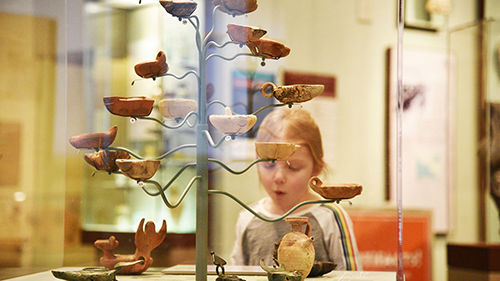From the President and Provost: Appointment of John McLaughlin as Interim Dean of Admissions
September 25, 2020
As you know, Eric Furda has decided to step down as dean of admissions on December 31, 2020 after more than 12 years of dedicated and exemplary service to Penn. We are pleased to announce that John McLaughlin will serve as interim dean of Admissions, effective January 1, 2021, and until a new dean of Admissions is in place.
John currently serves as vice dean and director of Admissions in Penn Admissions. In this senior leadership role, he manages the core elements of the admissions office, including the teams responsible for recruitment, selection, yield, and equity and access. During his term as director and under Dean Furda’s leadership, John and his team have consistently brought to Penn students who exemplify our commitment to diversity and excellence. John has also built deep relationships with faculty and key partners across campus, including through his service on the Faculty Council on Access and Academic Support. Before being promoted to vice dean, John helped create a research and analysis group in Penn Admissions that used experimental and data analytics to better understand and improve various aspects of the Penn Admissions process, including the campus visit experience, recruitment, and yield. A proud member of the Penn Class of 2005, John’s relationship with Penn Admissions began as a work-study student and a tour guide nearly 20 years ago. Between his student days and his return to Penn Admissions, John earned graduate degrees from Oxford and Harvard and was a senior research associate at the Consortium on Financing Higher Education (COFHE).
The search for Penn’s next Admissions dean is well underway and we have convened an Advisory Committee of Trustees, deans, senior administrators, faculty, and students to partner with us on this critically important search. We welcome your suggestions, input, and nominations as we work to identify and recruit an admissions leader who will help strengthen and expand our already exceptionally successful efforts to recruit to Penn the nation’s and the world’s most diverse and excellent students who will make unique contributions to our University community.
Please join us in again celebrating Eric Furda’s exceptional service to Penn and in thanking John McLaughlin for taking on this important interim leadership role for Penn Admissions. We look forward to keeping you updated in the months ahead on the search for Penn’s next Admissions dean.
—Amy Gutmann, President
—Wendell Pritchett, Provost
$4.5 Million NIH Grant to Penn to Build a Molecular Model of the Female Reproductive System

 The Penn Center for Multi-Scale Molecular Mapping of the Female Reproductive System, supported by the National Institutes of Health, will define a cellular atlas uncovering the complex interactions of cells that determine reproductive health.
The Penn Center for Multi-Scale Molecular Mapping of the Female Reproductive System, supported by the National Institutes of Health, will define a cellular atlas uncovering the complex interactions of cells that determine reproductive health.
Junhyong Kim, chair and Patricia M. Williams Professor of Biology in the School of Arts and Sciences, and Kate O’Neill, assistant professor, department of obstetrics and gynecology in the Perelman School of Medicine, have been awarded a Human BioMolecular Atlas Program (HuBMAP) grant supported by the Eunice Kennedy Shriver National Institute of Child Health & Human Development and the Common Fund of the National Institutes of Health. Drs. Kim and O’Neill are leading a multi-disciplinary team to create a comprehensive resource for women’s health by documenting the molecular characteristics of individual cells in the female reproductive system. This four-year, $4.5 million grant from the NIH along with support from the University of Pennsylvania School of Arts and Sciences, Perelman School of Medicine, and the Center for Research on Reproduction and Women’s Health will fund creation of the Penn Center for Multi-Scale Molecular Mapping of the Female Reproductive System.
The female reproductive system is composed of the uterus, fallopian tubes, and the ovaries. Together these organs are critical for the establishment of pregnancy, fetal development, and parturition and are central to common, costly, and debilitating disorders, including polycystic ovary syndrome, endometriosis, fibroids, and gynecologic cancers. Moreover, in addition to fertility, a functioning reproductive system is interrelated with overall health.
The new center, leveraging Penn’s leadership in single cell biology and reproductive biology, is an interdisciplinary effort requiring experts in gynecology, organ transplant, pathology, genomics, informatics, biomedical imaging and radiology. Co-investigators and collaborators involved in this project include: Kurt Barnhart, William Shippen Jr. Professor of Obstetrics and Gynecology; Ronny Drapkin, Franklin Payne Associate Professor of Pathology in Obstetrics and Gynecology; Jim Eberwine, Elmer Holmes Bobst Professor of Systems Pharmacology and Translational Therapeutics; Michael Feldman, professor of pathology and laboratory medicine; James Gee, associate professor of radiologic science and computer and information science; Nawar Latif, assistant professor of obstetrics and gynecology; Alison Pouch, assistant professor of radiology and bioengineering; Lauren Schwartz, assistant professor of clinical pathology and laboratory medicine; Abraham Shaked, Eldridge L. Eliason Professor of Surgery; all from the Perelman School of Medicine; Brian Gregory, associate professor and graduate chair of biology from the School of Arts and Sciences; and Arjun Raj, professor of bioengineering from the School of Engineering and Applied Science.
This important endeavor is made possible due to collaboration with the Gift of Life Donation Program and the generosity of donor families and Penn patients to participate in groundbreaking scientific research.
Wharton’s New Lecture Series to Focus on Racial Injustice
The Wharton School of the University of Pennsylvania recently announced the debut of a new, three-part Tarnopol Dean’s Lecture Series led by Wharton Dean Erika James entitled Beyond Business. It will tackle complex, pressing issues impacting individuals and organizations in the U.S. and around the world. With a goal of shining a light on the nation’s challenges with racial unrest, the inaugural set of discussions will focus on racial injustice. The first session, Race & The Entrepreneur, is set for October 21, at 12:30 p.m. ET and will look at the systemic issues of race that impact success for Black entrepreneurs and how industry and individuals can partner for meaningful change. All sessions are open to the public at no cost and will stream live to a global audience on the Wharton School’s LinkedIn page.
Barriers facing Black entrepreneurs include blocked access to investors, limited mentoring options, and fewer educational choices. Joining Dean James to tackle these challenges will be 1993 Wharton undergraduate alumnus Josh Kopelman, founding partner of First Round Capital, and 2007 Wharton undergraduate alumnus Chris Bennett, founder of Wonderschool. The second half of the session will feature a Q&A with the LinkedIn Live audience moderated by Wharton Vice Dean of Entrepreneurship and Innovation Karl Ulrich.
“Through this lecture series, Wharton is making a statement on the importance of prioritizing race and inclusion in America and asking firms to consider what it will take to place the issue at the top of the corporate agenda,” said Dean James. “I’m delighted such distinguished panelists will be joining me for the first session as we begin this conversation that will inspire others to make long-term change.”
Dean James began her tenure at Wharton on July 1, 2020, and in doing so became the first-ever woman and African American to lead the world’s oldest collegiate school of business. Prior to Wharton, she was dean of Goizueta Business School at Emory University. Throughout Dean James’ award-winning career as a researcher and instructor, she has investigated issues of diversity, leadership, and crisis management. She is the author of numerous journal articles, co-author of the book Leading Under Pressure: From Surviving to Thriving Before, During, and After a Crisis, and she was named one of the Top 10 Women of Power in Education by Black Enterprise magazine.
Subsequent Beyond Business sessions are planned for November (Race & Corporate Power) and December (Race & The Selling of America) and will feature additional acclaimed guest speakers. More information is available here.
Nominations for Women of Color Day 2021 Awards: November 6

To Members of the University and Surrounding Community:
The National Institute for Women of Color (NIWC) has proclaimed March 1 National Women of Color Day. Penn, UPHS, Penn Presbyterian Medical Center and Pennsylvania Hospital seek to increase awareness of the talents and achievements of women of color by recognizing them with the Women of Color Day Award.
The Women of Color Awards are given in recognition of individuals who have conscientiously endeavored to increase respect for women of color at Penn, University of Pennsylvania Health Systems, Penn Presbyterian Medical Center, Pennsylvania Hospitals and the Delaware Valley community. Annually, awards are given in up to five categories:
- Helen O. Dickens Award: must have demonstrated over 25 years of previously recognized service
- Joann Mitchell Outstanding Legacy Award
- Faculty/Staff, Graduate or Professional Student Award
- Undergraduate Student Award
- Community Member Award
Nominees must be affiliated with Penn, UPHS, Penn Presbyterian Medical Center or Pennsylvania Hospital and/or the local Philadelphia area and have demonstrated:
- Outstanding leadership
- Distinguished service
- Positive impact on the community
- Commitment to enhancing quality of life for and/or serving as a role model for women of color
Joann Mitchell Outstanding Legacy Award nominees must have worked with the Women of Color Executive Planning Committee or have proven support through donations, event involvement and action advocacy of the WOCAP mission.
Nominations must be submitted on or before November 6, 2020, to Lanese Rogers at larogers@upenn.edu.
Applications are available online at https://aarc.upenn.edu/women-color/women-color-awards.
Learn more about the 2021 WOCAP Day Awards Program at https://aarc.upenn.edu/women-color/programs.
—Women of Color Executive Planning Committee
Nominations: University-Wide Teaching Awards: December 4
Nominations for Penn’s University-wide teaching awards are now being accepted by the Office of the Provost. Any member of the University community—past or present—may nominate a teacher for these awards. There are three awards:
- The Lindback Award for Distinguished Teaching honors eight members of the standing faculty: four in the non-health schools (Annenberg, Weitzman, SEAS, GSE, Law, SAS, SP2, Wharton) and four in the health schools (Dental Medicine, PSOM, Nursing, Veterinary Medicine).
- The Provost’s Award for Distinguished PhD Teaching and Mentoring honors two faculty members for their teaching and mentoring of PhD students. Standing and associated faculty in any school offering the PhD are eligible for the award.
- The Provost’s Award for Teaching Excellence by Non-Standing Faculty honors two members of the associated faculty or academic support staff who teach at Penn, one in the non-health schools and one in the health schools.
The nomination forms are available at the Teaching Awards website. The deadline for nominations is Friday, December 4, 2020. Full nominations with complete dossiers prepared by the nominees’ department chairs are due Friday, February 5, 2021. For more information, please email provost-ed@upenn.edu or call (215) 898-7225.
Criteria and Guidelines
- The Lindback and Provost’s Awards are given in recognition of distinguished teaching. “Distinguished teaching” is teaching that is intellectually demanding, unusually coherent, and permanent in its effect. The distinguished teacher has the capability of changing the way in which students view the subject they are studying. The distinguished teacher provides the basis for students to look with critical and informed perception at the fundamentals of a discipline, and s/he relates that discipline to other disciplines and to the worldview of the student. The distinguished teacher is accessible to students and open to new ideas, but also expresses his/her own views with articulate and informed understanding of an academic field. The distinguished teacher is fair, free from prejudice, and single-minded in the pursuit of truth.
- Skillful direction of dissertation students, effective supervision of student researchers, ability to organize a large course of many sections, skill in leading seminars, special talent with large classes, ability to handle discussions or structure lectures—these are all attributes of distinguished teaching, although it is unlikely that anyone will excel in all of them. At the same time, distinguished teaching means different things in different fields. While the distinguished teacher should be versatile, as much at home in large groups as in small, in beginning classes as in advanced, s/he may have skills of special importance in his/her area of specialization. The primary criteria for the Provost’s Award for Distinguished PhD Teaching and Mentoring are a record of successful doctoral student mentoring and placement, success in collaborating on doctoral committees and graduate groups, and distinguished research.
- Since distinguished teaching is recognized and recorded in different ways, evaluation must also take several forms. It is not enough to look solely at letters of recommendation from students or to consider “objective” evaluations of particular classes in tabulated form. A faculty member’s influence extends beyond the classroom and individual classes. Nor is it enough to look only at a candidate’s most recent semester or opinions expressed immediately after a course is over; the influence of the best teachers lasts, while that of others may be great at first but lessen over time. It is not enough merely to gauge student adulation, for its basis is superficial; but neither should such feelings be discounted as unworthy of investigation. Rather, all of these factors and more should enter into the identification and assessment of distinguished teaching.
- The Lindback and Provost’s Awards have a symbolic importance that transcends the recognition of individual merit. They should be used to advance effective teaching by serving as reminders to the University community of the expectations for the quality of its mission.
- Distinguished teaching occurs in all parts of the University. Therefore, faculty members from all schools are eligible for consideration. An excellent teacher who does not receive an award in a given year may be re-nominated in some future year and receive the award then.
- The Lindback and Provost’s Awards may recognize faculty members with many years of distinguished service or many years of service remaining. The teaching activities for which the awards are granted must be components of the degree programs of the University of Pennsylvania.
Sachs Program for Arts Innovation Grants
Dear Penn Community Member,
We are writing today to announce the opening of the 2021 grant cycle for The Sachs Program for Arts Innovation. If you have an innovative and ambitious idea for the arts at Penn, you may be eligible for Sachs Program funding.
Over the summer we assessed our grants program, interviewing students, faculty, staff, and leadership at the University. One of the key findings of the assessment was to continue to build flexibility into our grants program, recognizing the range of needs on campus and the different planning horizons for various groups.
In response to the findings of the assessment, we have made several notable changes to the grants program for 2021:
- Annual Grant Opportunities for Penn faculty, staff, student groups, departments, programs, and centers are now consolidated into four core categories (Curricular, Project Grants, Independent Production, and Artist Residencies). Applications for these annual grants will be due January 22, 2021.
- Student Grants are now available twice a year. Fall student grants will be due November 20, 2020. Spring student grants will be due February 19, 2021.
- We will also be providing additional targeted grant opportunities in response to specific community needs, announced as opportunities are available.
Grants range in size, with most opportunities between $3,000 and $8,000. All grantmaking is aligned with the Sachs’ vision to support teaching art, making art, and presenting art, as well as their aim to provide Penn students with increased access to the arts and humanities. This year’s grant cycle provides multiple categories of arts funding that are open to the Penn community including faculty, staff, students, departments, programs, and centers.
If you would like to apply for Sachs funding, please visit our website at www.sachsarts.org.
Complete details on eligibility, deadlines, funding levels, and how to apply are available at www.sachsarts.org/grants. Please feel free to share this announcement with your friends and colleagues at Penn.
—The Sachs Program for Arts Innovation
Update to Penn Athletics’ Plan of Action: First Steps to Combat Racism
The University of Pennsylvania’s Division of Recreation and Intercollegiate Athletics is pleased to announce updates to its Plan of Action: First Steps to Combat Racism (released this summer; Almanac June 23, 2020) and the composition of its Racial Justice Task Force.
The Racial Justice Task Force, which has met regularly since July, is comprised of student-athletes, coaches, athletics administrators, alumni, and campus partners. The group represents a broad spectrum of backgrounds with the common goal of combatting racism and helping Penn Athletics become a more anti-racist organization.
The charge for this task force is to recommend action items to the Division of Recreation and Intercollegiate Athletics that include near- and long-term initiatives to improve and support the experience of people of color at Penn. The task force has been divided into sub-committees to allow for more focused discussions and planning in specific areas of the Plan of Action: First Steps to Combat Racism.
The task force will complete its full recommendations by the end of October. Responsibility for implementation will be transferred to an internal Diversity and Inclusion Committee of the Division, which will be led by the Athletics Diversity and Inclusion Designee, a new designation implemented by the NCAA this year.
“This task force is composed of an array of diverse minds, backgrounds, and experiences who are well situated to help our Division become a more accepting, supportive, and inclusive environment,” said M. Grace Calhoun, the T. Gibbs Kane, Jr. W’69 Director of Athletics and Recreation. “We have asked this task force to be thoughtful and deliberate as they provide recommendations to enact meaningful change within our Division and beyond. This is not an exercise in public relations; this is an effort to improve our Division’s support of our student-athletes, coaches, and staff of color, and to begin to break the chain of systemic racism.”
The following steps have already been taken as the Division strives to fulfill its Plan of Action.
Penn Athletics hosted three virtual “Addressing Racial Awareness” conversations this summer. Two were open to the entire Penn Athletics community and one was specific to coaches and staff. In June, Rev. Charles Howard C’00, (Vice President for Social Equity and Community), Brian Peterson, (Director of Makuu), and student-athletes Michae Jones C’21 (women’s basketball), Raven Sulaimon C’21 (volleyball), and Mitch Bartolo C’21 (men’s lacrosse) hosted a panel discussing racism, discrimination, police brutality, and actionable steps to take as individuals and members of the Penn community. In July, Ms. Jones, Ms. Sulaimon, and Mr. Bartolo were joined by Herman Beavers, (Faculty Director, Civic House Professor, English and Africana Studies) and Nat Graham C’97 (Associate Head Men’s Basketball Coach) for a conversation regarding different types of racism, allyship, and anti-racism. The Addressing Racial Awareness series will continue this fall with additional programming.
The position of Diversity and Inclusion Chair has been created for the Student-Athlete Advisory Committee (SAAC). Raven Sulaimon C’21 of the volleyball team has been named to this position in 2020-2021.
Penn Athletics will be offering implicit bias training to all student-athletes, coaches, and staff this fall in collaboration with the Penn LGBT Center and other campus partners.
Penn Athletics is producing social media and website content that promotes the impact of current and former student-athletes of color beginning this fall.
Penn Athletics is partnering with Penn Leads the Vote, a non-partisan student organization, to promote voter engagement and education.
Penn Athletics, the Ivy League, and the NCAA have designated Election Day as a day off from any required athletics activity, beginning this year and continuing into the future.
Penn Athletics is represented by Senior Associate AD/Chief Financial Officer Joy De Jesús WG’02 on the Ivy League Diversity and Inclusion Task Force.
Penn Athletics is actively exploring virtual civic engagement opportunities to positively impact the local West Philadelphia community.
The task force, chaired by Matt Valenti, C’07, Associate AD/Student-Athlete Success and Rudy Fuller, MSOD’20, Senior Associate AD/Intercollegiate Programs, is divided into four sub-committees:
Training and Education Sub-Committee
Objective: To provide resources for student-athletes, coaches, and staff and make recommendations for ongoing training and education.
- Rosemarie Burnett, Assistant AD/Academic Services and Student-Athlete Success
- Nia Caldwell, C’22, Student-Athlete, Women’s Track and Field
- Erin Cross, Director of the LGBT Center at Penn
- Steven Downs, Assistant Football Coach
- Nat Graham, C’97, Associate Head Men’s Basketball Coach
- Ufuoma Pela, Senior HR Director, Provost Center
Programming and Civic Engagement Sub-Committee
Objective: To create avenues for Penn Athletics to best support our student-athletes of color in their academic pursuits and community involvement. Identify a physical and inclusive gathering space for student-athletes of color and allies.
- Jen Capozzoli, SPP’17, Associate Director of Center for Student-Athlete Success
- Chloe Cole, Assistant Director, Fitness and Wellness
- Ryan Glover, W’21, Student-Athlete, Football
- Michae Jones, C’21, Student-Athlete, Women’s Basketball
- Sarah Parks, W’19, Director of Men’s Basketball Operations
- Roger Reina, C’84, Head Wrestling Coach
- Malik Washington, Director of Penn Violence Prevention
Building Our Community Sub-Committee
Objective: To collect demographic data on alumni and sport board composition. Approaches to recruiting and hiring racially-diverse student-athletes, coaches, and staff; equipment and financial inclusion.
- Kellie Vetter, Administrative Coordinator, Office of the Director of Athletics
- Rebecca Block, Associate Director HR, Provost Center
- Joy De Jesús, WG’02, Senior Associate AD/Chief Financial Officer
- Julie Durmala, Senior Accountant/Financial Analyst
- Stan Greene, C’78, Men’s Basketball Alum
- Erica Hildenbrand, Director of Recreational Programs
- Rev. Charles Howard, C’00, Vice President for Social Equity and Community & University Chaplain
- Nicole Maloy, W’95 SPP’18, Associate Dean, Equity & Access
- Meredith Schamun, Head Volleyball Coach
- Jelani Williams, C’21, Student-Athlete, Men’s Basketball
Marketing & Communications Sub-Committee
Objective: To identify and promote the historical impact of racially diverse student-athletes and alumni at Penn.
- Kevin Bonner, Senior Associate AD/Governance and Administration
- Mitch Bartolo, C’21, Student-Athlete, Men’s Lacrosse
- Denis Elton Cochran-Fikes, C’74, WG’79, Men’s Cross Country/Track and Field Alum
- Denise Fitzpatrick, Assistant AD/Marketing and Fan Engagement
- Mike Mahoney, Director of Athletic Communications
- Ray Priore, George A. Munger Head Football Coach
- Raven Sulaimon, C’21, Student-Athlete, Volleyball
- Jerome Williams, C’69, Men’s Track and Field Alum


 The Penn Center for Multi-Scale Molecular Mapping of the Female Reproductive System, supported by the National Institutes of Health, will define a cellular atlas uncovering the complex interactions of cells that determine reproductive health.
The Penn Center for Multi-Scale Molecular Mapping of the Female Reproductive System, supported by the National Institutes of Health, will define a cellular atlas uncovering the complex interactions of cells that determine reproductive health.
 Emile Bruneau, research associate and lecturer at the Annenberg School for Communication, director of Annenberg’s Peace and Conflict Neuroscience Lab, and lead scientist at the Beyond Conflict Innovation Lab, died September 30 from a brain tumor. He was 47.
Emile Bruneau, research associate and lecturer at the Annenberg School for Communication, director of Annenberg’s Peace and Conflict Neuroscience Lab, and lead scientist at the Beyond Conflict Innovation Lab, died September 30 from a brain tumor. He was 47. Susan Haas, lecturer in the Annenberg School for Communication and the School of Social Policy of Practice at the University of Pennsylvania, died September 25 from a heart attack. She was 63.
Susan Haas, lecturer in the Annenberg School for Communication and the School of Social Policy of Practice at the University of Pennsylvania, died September 25 from a heart attack. She was 63.

 The Harold W. McGraw, Jr. Prize in Education was recently awarded to Estela Bensimon, Michelene (Micki) Chi, and Joseph Krajcik. They were recognized for their achievements in higher education, learning science research, and pre-K-12 education, respectively.
The Harold W. McGraw, Jr. Prize in Education was recently awarded to Estela Bensimon, Michelene (Micki) Chi, and Joseph Krajcik. They were recognized for their achievements in higher education, learning science research, and pre-K-12 education, respectively.  Joan DeJean, Trustee Professor of Romance Languages in the department of French, was made a Fellow of the prestigious British Academy for the humanities and social sciences.
Joan DeJean, Trustee Professor of Romance Languages in the department of French, was made a Fellow of the prestigious British Academy for the humanities and social sciences. Christopher B. Murray, Richard Perry University Professor in Chemistry and in Materials Science and Engineering, has been selected as a Citation Laureate for 2020. The honor is awarded by Clarivate, the analytics company that operates the citation index Web of Science. This distinction goes to researchers whose work has been deemed “Nobel Class” by being among the most highly cited, and thus influential, in their fields.
Christopher B. Murray, Richard Perry University Professor in Chemistry and in Materials Science and Engineering, has been selected as a Citation Laureate for 2020. The honor is awarded by Clarivate, the analytics company that operates the citation index Web of Science. This distinction goes to researchers whose work has been deemed “Nobel Class” by being among the most highly cited, and thus influential, in their fields.


